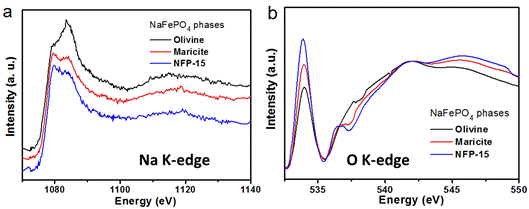| Revealing the atomistic origin of the disorder-enhanced Na-storage performance in NaFePO4 battery cathode |
| From: PublishDate:2020-07-31 Hits: |
Among the various SIBs cathode materials, NaFePO4 attracts much attention owing to its high theoretical capacity (155 mAh g-1), low cost, high structural stability, and non-toxicity. Nevertheless, the NaFePO4 with maricite structure, thermodynamically stable phase, has been considered as electrochemically inactive for sodium-ion storage. A team from State Key Laboratory of Silicate Materials for Architectures of Wuhan University of Technology has improved the electrochemical activity of maricite NaFePO4 via disordering engineering and revealed the atomistic origin of the disorder-enhanced Na-storage performance. Their research has been published in Nano Energy. The team fabricated a series of NaFePO4 polymorphic composites with different content of amorphous phase by tuning the ball-milling parameters and confirmed the proportional relation between the content of amorphous phase and the sodium storage capacity. The optimized initial capacity of 115 mAh g-1 at 1 C with the capacity retention of 91.3% after 800 cycles was demonstrated, which could be ascribed to the synergistic effect of the active amorphous phase favoring the high sodium-ion storage performance and the inactive ordered maricite phase boosting the structural stability. In addition, they investigated the structural differences of NaFePO4 with different crystal phase and amorphous one, and proposed the atomistic origin of the disorder-enhanced Na-storage performance.
The XANES spectra obtained by using synchrotron radiation at BSRF: (a) Na K-edge and (b) O K-edge. The results demonstrate that the nearest coordination environment of Na in the milling-induced amorphous NaFePO4 phase is similar to that in the maricite phase, while the nearest coordination number of O in amorphous NaFePO4 phase is decreased compared to that in maricite phase. Synchrotron radiation helps the team to study the local coordination environment of sodium and oxygen in different crystalline and amorphous phases, which provides important support for reasonably determining the atomic scale structure origin of disorder-enhanced Na-storage performance in NaFePO4. Based on the XANES and Raman spectroscopy, the team proposed the atomic-scale structural model of amorphous NaFePO4, and the transformation of edge-sharing FeO6 octahedra into various FeOn polyhedra upon amorphization was considered to be a key to attain the superior performances for Na ion batteries. Article: Fangyu Xiong, Qinyou An, Lixue Xia, Yan Zhao, Liqiang Mai, Haizheng Tao*, Yuanzheng Yue*; Revealing the atomistic origin of the disorder-enhanced Na-storage performance in NaFePO4 battery cathode, Nano Energy, 2019, 57, 608-615. |
|
|
| Chinese
- Metal-free efficient photocatalyst for stable visible water splitting——Top ten major scientific progresses in China in 2015
- The nano-resolution imaging platform was awarded the first rate prize of Beijing Science and Technology in 2014
- Beamline 1W1 of BSRF started to runoperate in the couplingparasitic mode of BEPCII
- Synthesis of High Performance Polymer Materials for Field Effect-Transistors
- Surfactant molecular aggregates in green solvents
- GIXRD has played an important role in the characterization of organic thin-film transistors
Copyright © 2011 - 2012 Beijing Synchrotron Radiation Facility


